Punjab State Board PSEB 10th Class Maths Book Solutions Chapter 12 Areas Related to Circles Ex 12.3 Textbook Exercise Questions and Answers.
PSEB Solutions for Class 10 Maths Chapter 12 Areas Related to Circles Ex 12.3
Question 1.
Find the area of the shaded region in Fig., If PQ = 24 cm, PR =7 cm and O is the centre of the circle.
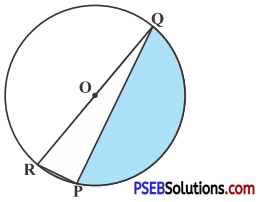
Solution:
PQ = 24 cm
PR = 7 cm
RQ is diameter of circle
∠RPQ = 90° Angle in semi circle
In ∆PQR,
QR2 = RP2 + PQ2
QR = \(\sqrt{(7)^{2}+(24)^{2}}=\sqrt{49+576}\)
= \(\sqrt{625}\)
QR = 25 cm
∴ Diameter of circle (QR) = 25 cm
Radius of circle (R) = \(\frac{25}{2}\) cm
Area of shaded region = Area of the semicircle – Area of ∆RPQ
= \(\frac{1}{2} \pi \mathrm{R}^{2}-\frac{1}{2} \mathrm{RP} \times \mathrm{PQ}\)
= \(\left[\frac{1}{2} \times \frac{22}{7} \times \frac{25}{2} \times \frac{25}{2}-\frac{1}{2} \times 7 \times 24\right]\) cm2
= \(\left[\frac{6875}{28}-84\right]\)
= 245.53 – 84 = 161.53 cm2
∴ Area of shaded region = 161.53 cm2.
![]()
Question 2.
Find the area of the shaded region in Fig., if radii of the two concentric circles with centre O are 7 cm and 14 cm respectively and ∠AOC = 40°.
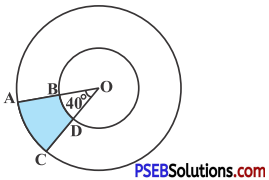
Solution:
Radius of smaller circle (r) = 7 cm
Radius of bigger circle (R) = 14 cm
Central angle ∠AOC (θ) = 40°
Area of shaded region = Area of bigger sector OAC – Area of smaller sector OBD
= \(\frac{\pi \mathrm{R}^{2} \theta}{360^{\circ}}-\frac{\pi r^{2} \theta}{360^{\circ}}\)
= \(\frac{\pi \theta}{360^{\circ}}\) [R2 – r2]
= \(\frac{22}{7} \times \frac{40}{360}\) × [142 – 72]
= \(\frac{22}{63}\) [196 – 49]
= \(\frac{22}{63}\) × 147 = 51.33 cm2
∴ Shaded Region = 51.33 cm2.
![]()
Question 3.
Find the area of the shaded region in fig., if ABCD is a square of side 14 cm and APD and BPC are semi circles.
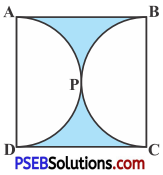
Solution:
Side of square = 14 cm
Diameter of semicircle (AB = BC) = 14 cm
Radius of semi circle (R) = 7 cm
Area of square = (Side)2
= 14 × 14 = 196cm2
Area of a semi circles = \(\frac{1}{2}\) πR2
= \(\frac{1}{2} \times \frac{22}{7}\) × 7 × 7
= 77 cm2
Area of two semi circle = 2(77) = 154 cm2
Area of shaded region = Area of square ABCD – Area of two semi circles
= (196 – 154) = 42 cm2
Area of shaded region = 42 cm2.
![]()
Question 4.
Find the area of the shaded region in fig., where a circular arc of radius 6 cm has been drawn iith vertex O of an equilateral triangle OAB of side 12 cm as centre.
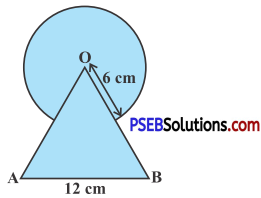
[Each angle of equilateral triangle is 60°]
Area of major sector of circle = Area of circle – Area of sector
= πR2 – \(\frac{\pi \mathrm{R}^{2} \theta}{360^{\circ}}\)
= \(\frac{22}{7}\) × 6 × 6 – \(\frac{22}{7}\) × 6 × 6 × \(\frac{60}{360}\)
= \(\frac{22}{7}\) × 6 × 6 1 – \(\frac{60}{360}\)
= \(\frac{22}{7}\) × 36 1 – \(\frac{1}{6}\)
= \(\frac{22}{7}\) × 36 × \(\frac{5}{6}\)
= 94.28 cm2
∴ Area of major sector of circle = 94.28 cm2
Area of equilateral triangle OAB = \(\frac{\sqrt{3}}{4}\) (side)2
= \(\frac{1.73}{4}\) × 12 × 12
= 1.73 × 36 = 62.28 cm2
Shaded Area = Area of equilateral triangle OAB + Area of major sector of circle
= 62.28 + 94.28 = 62.28 cm2
Shaded Area = Area of equilateral triangle OAR + Area of major sectoç of circle
= 62.28 + 94.28 = 156.56
Shaded Area = 156.56 cm2.
![]()
Question 5.
From each corner of a square of side 4 cm a quadrant of a circle of radius 1 cm is cut and also a circle of diameter 2 cm is cut as shown in fig. Find the area of the remaining portion of the square.
Solution:
Side of square = 4 cm
Radius of each semi circle cut out (r) = 1 cm
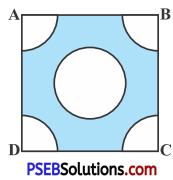
Diameter of circle (R) = 2 cm
.. Radius of circle (R) = 1 cm
Area of square = (Side)2
= (4)2 = 16 cm2
Area of 4 quadrants = 4\(\left[\frac{\pi^{2} \theta}{360^{\circ}}\right]\)
= \(\frac{4 \times 90}{360} \times \frac{22}{7} 1 \times 1\)
= 1 × \(\frac{22}{7}\) × 1 × 1 = 3.14 cm2
Area of circle = πR2
= \(\frac{22}{7}\) × 1 × 1
Area of circle = 3.14 cm2
Required area = Area of square – Area of 4 quadrants – Area of circle
= (16 – 3.14 – 3.14) cm2 = 9.72 cm2
Required Area = 9.72 cm2.
![]()
Question 6.
In a circular table cover of radius 32 cm, a design is formed leaving an equilateral triangle ABC in the middle as
shown in fig. Find the area of the design (shaded region).

Solution:
Radius of table cover (R) = 32 cm
OA = OB = OC = 32 cm
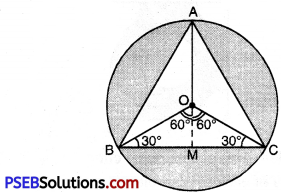
∆ABC is equilateral triangle with AB = AC = BC
∠AOB = ∠BOC = ∠COA = 120°
Now, in ∆BOC,
From O draw, angle bisector of ∠BOC as well as perpendicular bisector 0M of BC.
∴ BM = MC = \(\frac{1}{2}\) BC
Also, OB = OC [radii of the circle]
∴ ∠B = ∠C
∴ ∠O + ∠B + ∠C = 180°
120° + 2∠B = 180°
∠B = 30°
and ∠B = ∠C = 30°
Also, ∠BOM = ∠COM = 60°
∆OMB ≅ ∆OMC [RHS Cong.]
∴ In ∠OMB,
∠OBM = 30° [∠O = 60° and ∠M = 90°]
∴ \(\frac{\mathrm{BM}}{\mathrm{OB}}\) = cos 30°
BM = 16√3 cm.
∴ BC = 2 MB = 32√3 cm
Area of circle = πR2 = \(\frac{22}{7}\) × (32)2
= \(\frac{22}{7}\) × 32 × 32 = 3218.28 cm2
Area of ∆ABC = 4 (side)2
= \(\frac{1.73}{4}\) × 32√3 × 32√3 = 1328.64 cm2
∴ Required Area = Area of circle – Area of ∆ABC
= 3218.28 – 1328.64 = 1889.64 cm2
![]()
Question 7.
In fig., ABCD is a square of side 14 cm. With centres A, B, C and D, four circles are drawn such that each circle touch externally two of the remaining three circles. Find the area of the shaded region.
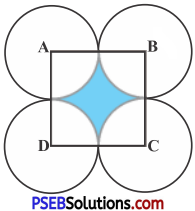
Solution:
Side of square ABCD = 14 cm
Radius of circle (R) = 7 cm
Sector angle (θ) = 90° [Each angle of square 90°]
Area of square = (side)2
= 14 × 14 = 196 cm2
Area of four quadrants = 4 \(\left[\frac{\pi R^{2} \theta}{360}\right]\)
= 4 × \(\frac{22}{7} \times \frac{7 \times 7 \times 90}{360}\)
= 22 × 7 = 154 cm2
∴ Required shaded area = Area of square – Area of 4 quadrants
= 196 – 154 = 42 cm2.
Question 8.
Fig. depicts a racing track whose left and right ends are semicircular. The distahce between the two inner parallel line segments is 60 m and they are each 106 m long. 1f the track is 10 m wide, find
(i) the distance around the track along its inner edge.
(ii) the area of the track.

Solution:
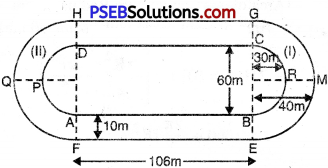
(i) Here AB = DC = 106 m
AF = BE = CG = HD = 10m
Diameter of inner semicircle (APD and BRC) =60 m
∴ Radius of inner semicircle (APD (r) = 30 m
Radius of outer semicircle (R) = r + 10 = 30 + 10 = 40 m
Distance around the track along inner edge = AB + circumference of semi circle BRC + CD + circumference of semi circle DPA
= 2 AB + 2 [circumference of semi circle BRC]
= 2 (106) + 2(\(\left(\frac{2 \pi r}{2}\right)\))
= 212 + 2πr
= 212 + 2 × \(\frac{22}{7}\) × 30
= 212 + \(\frac{60 \times 22}{7}\)
= 212 + 188.57 = 400.57 m.
∴ Distance around the track along its inner edge = 400.57 m
(ii) Area of track = Area of rectangle ABEF + Area of region BEMGCRB + Area of rectangle CGHD + area of region.
= 2 Area of rectangle ABCD + 2 Area of region (II)
= 2 (AB × AF) + 2
[Area of semi circle with Radius 60 cm – Area of semi circle with radius 30 cm]
= 2 [106 × 10] + 2 [latex]\frac{\pi \mathrm{R}^{2}}{2}-\frac{\pi r^{2}}{2}[/latex]
= 2 × 1060 + \(\frac{2 \pi}{2}\) [R2 – r2]
= 2120 + \(\frac{22}{7}\) (402 – 302)
= 2120 + \(\frac{22}{7}\) [1600 – 900]
= 2120 + \(\frac{22}{7}\) [700]
= 2120 + 2200 = 4320 m2
Area of track = 4320 m2
Question 9.
In Fig., AB and CD are two diameters of a circle (with centre O) perpendicular to each other and OD is the diameter of the smaller circle. If OA = 7 cm, find the area of the shaded region.
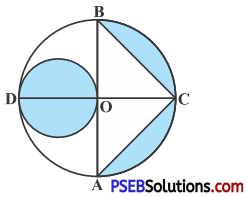
Solution:
Diameter of circle = 14 cm
Radius of circle = 7 cm
Diameter of smaller circle = 7 cm
∴ Radius of smaller circle = \(\frac{7}{2}\) cm
Since AB and CD are to perpendicular the diameters of a circle,
∴ AO ⊥ CD
Area of bigger circle = πR2 × 7 × 7 = 154 cm2
Area of bigger semicircle = \(\frac{154}{2}\) = 77 cm2
Area of smaller circle = πr2
= \(\frac{22}{7} \times \frac{7}{2} \times \frac{7}{2}\)
= 38.50 cm2
Area of ∆ABC = \(\frac{1}{2}\) Base × Altitude
= \(\frac{1}{2}\) × 14 × 7 = 49 cm2
∴ Shaded Area = Area of bigger semi circle + Area of smaller circle – Area of triangle
= (77 – 49 + 38.5) cm2 = 66.5 cm2
Question 10.
The area of an equilateral triangle ABC is 17320.5 cm2. With each vertex of the triangle as centre, a circle is drawn with radius equal to half of the length of the side of the triangle (see Fig.). Find the area of the shaded region.
(Use n = 3.14 and ,√3 = 1.73205)

Solution:
Area of equilateral triangle ABC = 17320.5 cm2
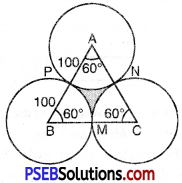
\(\frac{\sqrt{3}}{4}\) (side)2 = 17320.5
(side)2 = \(\frac{17320.5 \times 4}{1.73205}\)
(side)2 = \(\frac{173205}{10} \times \frac{100000 \times 4}{173205}\)
side = \(\sqrt{4 \times 100 \times 100}\)
side = 2 × 100 = 200 cm
AB = BC = AC
Radius of circle (R) = \(\frac{A B}{2}=\frac{200}{2}\) = 100 cm
Sector angle, θ = 60°
Area of sector APN = \(\frac{\pi \mathrm{R}^{2} \theta}{360}\)
= \(\frac{3.14 \times 100 \times 100 \times 60}{360}\)
= \(\frac{15700}{3}\)
Area of three sector = 3 × \(\frac{15700}{3}\) cm2
∴ Required shaded Area = Area of triangle – Area of three sectors
= 17320.5 – 15700 = 1620.5 cm2
∴ Hence, Required shaded Area = 1620.5 cm2
Question 11.
On a square handkerchief, nine circular designs each of radius 7 cm are made (see Fig). Find the area of the remaining portion of the handkerchief.
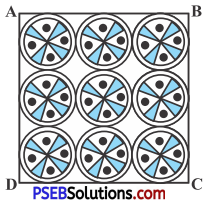
Solution:
Radius of circle (R) = 7 cm
Diameter of circle = 2 × R = 2 × 7 = 14 cm
Since there are three circles along a side of square
∴ side of squrae = 3 [14] = 42 cm
Total area of handkerchief = Area of square = (side)2
= (42)2 = 1764 cm2.
Area of 9 circular designs = 9πR2
= 9 × \(\frac{22}{7}\) × (7)2
= 9 × \(\frac{22}{7}\) × 7 × 7
= 9 × 154 = 1386 cm2
∴ Required area of remaining portion = Area of square – Area of 9 circular designs
= 1764 – 1386 = 378 cm2
∴ Required area of remaining portion = 378 cm2.
Question 12.
In Fig., OACB is a quadrant of a circle with centre O and radius 3.5 cm. If OD = 2 cm, find the area of the
(i) quadrant OACB,
(ii) shaded region.
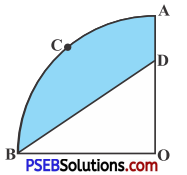
Solution:
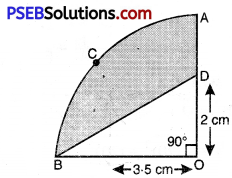
Radius of quadrant (R) = 3.5 cm
Angle of sector (θ) = 90°
OD = 2 cm.
(i) Area of quadrant OACB = \(\frac{\pi \mathrm{R}^{2} \theta}{360}\)
= \(\frac{22}{7} \times \frac{3.5 \times 3.5 \times 90}{360}\) = 9.625 cm2.
(ii) Area of ODB = \(\frac{1}{2}\) Base × Altitude
= \(\frac{1}{2}\) × 3.5 × 2 = 3.5 cm2
∴ Shaded Area = Area of quadrant OACB – Area of ∆ODB
= 9.625 – 3.5 = 6.125 cm2
∴ Hence, Shaded Area = 6.125 cm2.
Question 13.
In fig., a square OABC is inscribed in a quadrant OPBQ. If OA = 20 cm, find the area of the shaded region.
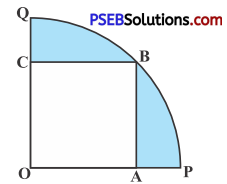
Solution:
Side of square ABCO = 20 cm
∠AOC = 90°
AB = OA
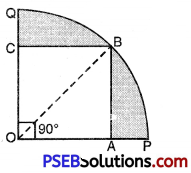
OB2 = OA2 + AB2
OB = \(\sqrt{(20)^{2}+(20)^{2}}\)
= \(\sqrt{400+400}\)
= \(\sqrt{800}=\sqrt{400 \times 2}\)
OB = 20√2 cm
Area of square OABC = (side)2 = (20)2
∴ Area of square = 400 cm2
Radius of quadrant (R) = 20√2 cm
Sector angle (θ) = 90°
∴ Area of sector = \(\frac{\pi \mathrm{R}^{2} \theta}{360^{\circ}}\)
= \(\frac{3.14 \times 20 \sqrt{2} \times 20 \sqrt{2} \times 90}{360}\)
= 2 × 314 cm2 = 628 cm2
Required shaded Area = Area of sector – Area of square
= (628 – 400) cm2 = 228 cm2
Question 14.
AB and CD are respectively arcs of two concentric circles of radii 21 cm and 7 cm and centre O. If ZAOB = 30°, find the area of the shaded region.
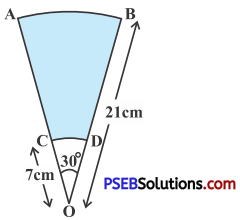
Solution:
Radius of sector OBA (R) =21 cm
Radius of sector ODC (r) 7 cm
Sector angle (θ) = 30°
Area of bigger sector (OAB) = \(\frac{\pi \mathrm{R}^{2} \theta}{360^{\circ}}\)
= \(\frac{22}{7} \times \frac{21 \times 21 \times 30}{360}\) = 115.5 cm2
Area of smaller sector (ODC) = \(\frac{\pi \mathrm{R}^{2} \theta}{360^{\circ}}\)
= \(\frac{22}{7} \times \frac{7 \times 7 \times 30}{360}\) = 12.83 cm2
Area of smaller sector (ODC) = 12.83 cm2
Now, Shaded Area = Area of bigger sector OAB – Area of smaller sector OCD
= 115.5 – 12.83 = 102.66
Hence, Shaded Area = 102.66 cm2.
Question 15.
In fig., ABC is a quadrant of a circle of radius 14 cm and a semi circle is drawn with BC as diameter. Find the area of the shaded region.
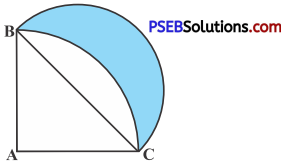
Solution:
Radius of quadrant ACPB (r) = 14 cm
Sector angle (θ) = 90°
AB = AC = 14 cm
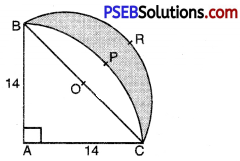
Area of triangle = \(\frac{1}{2}\) AB × AC
= \(\frac{1}{2}\) × 14 × 14
= 98 cm2
Area of sector ACPB = \(\frac{\pi \mathrm{R}^{2} \theta}{360^{\circ}}\)
= \(\frac{22}{7} \times \frac{14 \times 14 \times 30}{360}\) = 154 cm2
∴ Area of BOCPB = Area of sector ABPC – Area of \ABC
= 154 cm2 – 98 cm2 = 56 cm2
In ∆BAC, AB2 + AC2 = BC2
(14)2 + (14)2 = BC2
BC = \(\sqrt{196+196}=\sqrt{2(196)}\) = 14√2
∴ Radius of semi circle BOCR = \(\frac{14 \sqrt{2}}{2}\) = 7√2
Area of semi circle = \(\frac{\pi \mathrm{R}^{2}}{2}\)
= \(\frac{22}{7} \times \frac{7 \sqrt{2} \times 7 \sqrt{2}}{2}\)
= \(\frac{22}{7} \times \frac{7 \times 7 \times 2}{2}\)
= 154 cm2
Required Area = Area of semi circle – [Area of sector – Area of ∆BAC]
= 154 – [154 – 98]
= (154 – 56) cm2 = 98 cm2
Hence, Shaded Area = 98 cm2.
Question 16.
Calculate the area of the designed region in fig. common between the two quadrants of circles of radius 8 cm each.
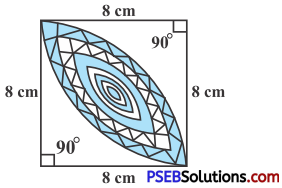
Solution:
Side of square = 8 cm
Area of square = (8)2 = 64 cm2
Line BD divides square ABCD into the equal parts
Area of ∆ABD = ar of ∆BDC
Sector angle θ = 90°
Area of sector = \(\frac{\pi \mathrm{R}^{2} \theta}{360}\)
= \(\frac{22}{7} \times \frac{8 \times 8 \times 90}{360}\)
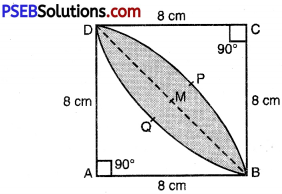
Area of sector = 50.28 cm2
Area of ∆ABD = \(\frac{1}{2}\) × AB × AD
= \(\frac{1}{2}\) × 8 × 8
= 32 cm2
∴ Area of segment DMBPD = Area of sector ∆BPD – Area of ∆ABD
= 50.28 – 32 = 18.28 cm2
Hence, Shaded area = 2 area of segment DMBPD = 2 (18.28) = 36.56 cm2
